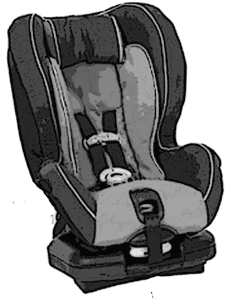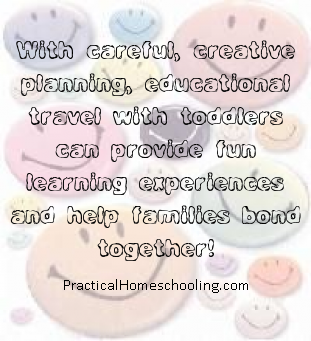Toddler Travel: Top Ten Tips for Enjoying—Not Just Surviving—Educational Trips
By Melissa Morgan
Printed in Practical Homeschooling #93, 2010.
 Top 10 tips for traveling with toddlers. Enjoy your trip, don’t just survive it!
Top 10 tips for traveling with toddlers. Enjoy your trip, don’t just survive it!

| 
|
You’d love to treat your toddler to an educational trip. Wouldn’t your
little one enjoy visiting wild animal parks, dinosaurs at a museum,
Native American reservations, beaches, boat races, ranches, and
sporting events? If you could only get your squirmy youngster to sit
still long enough to get anywhere. And what about potty training,
special food, the “gimmie-gimmies,” and tummy aches?
 It sounds like too much trouble, but with careful, creative planning,
educational travel with toddlers can provide fun learning experiences
and help families bond together.
It sounds like too much trouble, but with careful, creative planning,
educational travel with toddlers can provide fun learning experiences
and help families bond together.
Here are the top ten tips to make it work.
1. Enforce Discipline Wisely
Work on discipline at home before the trip, and don’t leave home
without it. Have “dry run” pretend practices on how to behave in
public. For a lighter touch, check out books such as Stan and Jan
Berenstain’s The Berenstain Bears and Too Much Vacation, and The
Berenstain Bears Get the Gimmies.
Let your children know ahead of time that if they break a rule, there
will be consequences. Clearly explain, and remind your child often of
what will happen if they obey (good things), and what will happen if
they disobey (bad things).
Enforce your rules when you are out, but you may need to alter them
slightly to fit the situation. If you practice biblical spanking at
home, avoid doing it in public, as it can be misinterpreted by
strangers. Wait until you are in a private place to spank.
2. Eat Well
Make sure that both toddlers and grownups are well fed while
traveling. Like an army, a family travels on its stomach. Hungry
people have shorter tempers and less tolerance for the inevitable
travel irritations.
If your toddler can eat small foods without choking, stave off boredom
with snacks that take a long time—and a lot of energy—to eat, such as
raisins and small cereals. If possible, obtain individual serving
containers with covers. These can make eating more fun and less messy.
Avoid sugary, artificial ingredients in food and drinks, if they tend
to make your kids more active or jittery. In my experience, someone
always gets a tummy ache in the car; it may pay to bring medicine for
that, if your doctor approves.

3. Sleep Well
Make sure everyone gets enough rest, both before and during the trip.
Even if you plan to “rough it,” bring snuggly sleeping bags,
inflatable mattresses, and comfy pillows. Parents need to remember to
get enough rest, too.
I can’t say I’ve always been completely successful with this. I’ve
overcommitted to activities and stayed up too late packing the night
before a trip. However, my whole family picks up my mood, and I’m
trying to get more rested and relaxed. The old saying is often true:
“If Mama’s not happy, nobody’s happy!”
4. Plan Well
The family that fails to plan, plans to fail. For extended trips,
start planning several months in advance, if possible. Include your
toddler in your plans. Your child can begin to learn about calendars
if you share your planning dates. Teach your little one to look at
maps with you: large and colorful maps are better. Use the Internet
and library, and research destinations and activities together. Teach
your child about safety concerns before the trip. Use resources such
as boatsafe.com/kids/index.htm.
Educator’s discounts are often available for homeschoolers at theme
parks and other attractions. Also use your educator’s card to buy
tourism books, nature guides, atlases, etc.
Find out about National Park services at nps.gov/parks.html and get
travel discounts and information at
consumerworld.org/pages/travel.htm. Take a local trip to hotels where
you live and pick up one of their free chain guides, listing
locations, accommodations, prices, etc. Look up the state and town
where you will be staying.
5. Assign Jobs
Everyone in the family can have a position of responsibility before,
during, and after the trip. For instance, toddlers, with help, can
pick out clothing to bring. Provide specific guidelines: how many
socks, underclothes, shirts, etc., will be needed? Remember to bring
extra clothing in case of accidents (they almost always happen when
they are most inconvenient), and keep cleanup supplies handy. Most
kids can learn to pack and carry their own kid-sized backpacks and
luggage. Even a small child can help prepare simple snacks, such as
scooping out dry cereal into a plastic container.
Yes, it will take more time to teach them to do a job, than it would
if you just did it yourself. However, toddlers can learn
responsibility, develop a sense of accomplishment, and stay busy
helping. For non-reading youngsters, consider giving them a picture
chart of assignments; they can check off each item as they do it.
6. Consider Everyone’s
Interests
Spend some family time brainstorming ideas for trips several months
ahead of time. Toddlers might not have any idea what kind of trip they
might enjoy. Help them get started by reminding them of things that
they like to do at home. Adults have interests, too; how can you share
them with your toddler? Start simply, and keep exposure to new ideas
short at first. An all-day trip to a museum, where children are not
allowed to talk or touch, can give a negative impression. However, a
few hours in a hands-on outdoor nature center or recreated historical
outdoor village can create a life-long interest.
Bring plastic bags and jars for collecting items such as shells and
rocks. Make sure that you are allowed to pick up and keep items, as
some areas do not permit this. If so, you can usually keep a record,
by photographing interesting finds.
7. Stop Often
It may seem like a good idea to just keep going and get the trip over
with, regardless of the whining and tears. However, a short rest
stop—even five minutes to run around a park—can make the difference
between strengthened family ties and bitter, grumpy, unpleasant
people.
During rest stops, do something active: kick balls, challenge each
other to races, and throw a Frisbee.
Plan to stop when you first come into the state on the interstate
highway. While little ones stretch their muscles, you can pick up free
information and maps about events and educational outings. You will
likely find fliers for museums and parks, restaurant discount coupons,
tourist information, and hotel discounts.
8. Contingency Pack
Don’t worry about forgetting to pack items that you can pick up at any
supermarket or drug store once you arrive at your destination.
However, that special blankie, sippy cup, water bottle, or teddy bear
is irreplaceable.
Usually the trip itself, not the destination, is the most challenging
part of the vacation. For youngsters still reluctant to use big
bathroom facilities, bring a portable potty or toddler seat, packed in
a plastic carry bag.
Remember to keep items handy that will keep toddlers happy while
traveling, such as healthy snacks, if they might be difficult to
obtain on the way. For months before a trip, I keep my eyes out for
inexpensive games, crafts, and special toys to dole out periodically
throughout the trip. Lap desks and trays can be stored under seats
when you aren’t using them and brought out when needed. Something new
is always much more absorbing, but it pays to avoid inflated prices at
tourist traps and highway rest stops.
9. Keep Hands Busy
Your toddler will have to sit still, sometime during the trip. Some
families resort to portable game machines or videos; however, travel
is an opportune time for creative play. Bring along bags with large
beads and string, safety scissors and old magazine pictures or
greeting cards to cut up, new color-with-water books and brushes, even
play clay and molds. Yes, they can be messy, so bring cleaning
materials as well. Use travel time to train your toddler to clean up.
Find more ideas to keep kids busy on trips at Go Camping America Kids
Pages, gocampingamerica.com/kidspages.
10. Recognize Special Needs & Limits
Small children who have mental, physical, or health challenges may
need special accommodations. Carefully check out details ahead of
time. Call or write and find out if your destination can make
allowances for your family member. For instance, people with
disabilities may be able to receive special permission to avoid long
waiting lines in theme parks.
You may wish to start small: a short trip, or even a day trip instead
of overnight. Sometimes it is more realistic to attend a noisy
baseball game instead of the opera. Maybe an outdoor picnic at a park
on the other side of town is enough of an adventure. A creatively
planned picnic can be an elaborate, exciting excursion; find out more
at the-picnic-site.com.
If you find travel difficult or impossible due to special needs, you
may be able to give your child a taste of travel with a virtual trip,
traveling the world through computer games, videos or the Internet.
Visit Antarctica, Cameroon, Central America, or Zimbabwe, at
lonelyplanet.com/destinations. Meet virtual animals with National Zoo
Animal Web cams at nationalzoo.si.edu/Animals/default.cfm. Take your
toddler on a tour of the world or even the moon, with Google Earth,
earth.google.com/tour.html.
And Here’s a Bonus Tip: Memorialize Your Trip
However or wherever your toddler adventures take you, keep a record of
your trip. After you return home and have rested, spend an evening
scrap-booking together. (Find free scrap-booking supplies at
scrapbookscrapbook.com/beginners.html.)
As your youngsters grow into teens, and then young adults, even the
most difficult toddler travel challenges can become some of your most
precious, rewarding and enduring memories.
Melissa L. Morgan is the co-author of Educational Travel on a
Shoestring and Homeschooling on a Shoestring. With her husband, Hugh,
she has homeschooled their three children from birth, taking advantage
of many educational opportunities in the real world. She invites you
to visit her website at www.eaglesnesthome.com.